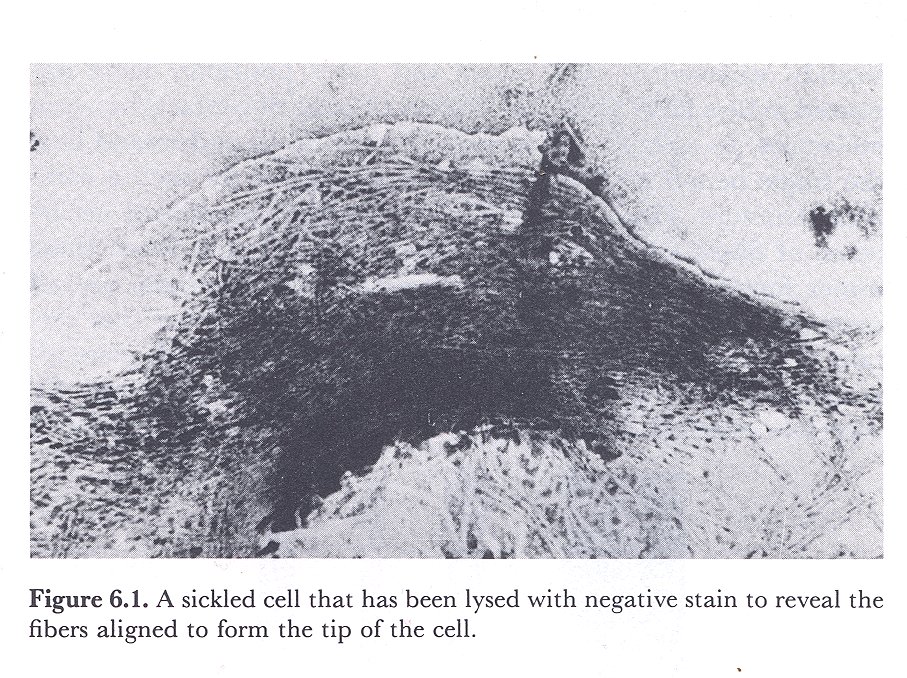A Brief History of the Discovery Sickle
Cell Anemia
Sickle cell anemia was the first diagnosed disease that was
linked to the hemoglobin protein and genetically characterized. In 1910
Sickle cell disease was first characterized when Dr. B. Herrick wrote a
report about a patient who suffered from a "strange disease" including
such symptoms as asthmatic conditions and blood flow problems including
body ulcers (Linde,
1972). The study led to the locating of a new sickle cell hemoglobin
(HbS) that was predicted in the 1940’s by Linus
Pauling (Johnson,
1984). Three researchers discovered that HbS had a lower solubility
than normal hemoglobin: Pertuz and Mitchson examined HbS solubility and
Harris "observed spindle shaped liquid crystals" that formed in the de-oxygenated
hemoglobin
(Johnson,
1984). Linus Pauling again hypothesized on the nature of HbS and its
role in sickle cell anemia in 1952 by saying that the HbS proteins may
act differently from regular hemoglobin (HbA)  and
stack together. Pauling’s new hypothesis together with the old stated that
the sickling of the cells in sickle cell anemia may be due to the formation
of "rods" by the hemoglobin and thus "sickle" the cell (Johnson,
1984 ).
and
stack together. Pauling’s new hypothesis together with the old stated that
the sickling of the cells in sickle cell anemia may be due to the formation
of "rods" by the hemoglobin and thus "sickle" the cell (Johnson,
1984 ).
From these hypothesizes and experiments a physical understanding
of sickle cell disease was formed although no effective cures had been
found. The physical mapping of the hemoglobin protein for every amino acid
allowed it to be one of the first human
genetic diseases to be characterized genetically. The difference between
HbA hemoglobin and HbS hemoglobin is a one base pair difference, a transversion
of A to T in the beta -globin gene. This transversion at the sixth codon
leads to a change in a hydrophobic amino acid to a hydrophilic amino acid
with very different physical properties and an overall change in the  hemoglobin
structure and red blood cell function.
hemoglobin
structure and red blood cell function.
Even with these physical and genetic clues that have been
around for decades cures and treatments of sickle cell anemia are barely
touched on. New methods are being developed now using the genetical advances
of today to change the research field of sickle cell anemia, but why has
the development of these treatments taken so long?
<BACK
A PAGE
OUTLINE
PAGE
TO NEXT PAGE>
 and
stack together. Pauling’s new hypothesis together with the old stated that
the sickling of the cells in sickle cell anemia may be due to the formation
of "rods" by the hemoglobin and thus "sickle" the cell (Johnson,
1984 ).
and
stack together. Pauling’s new hypothesis together with the old stated that
the sickling of the cells in sickle cell anemia may be due to the formation
of "rods" by the hemoglobin and thus "sickle" the cell (Johnson,
1984 ). and
stack together. Pauling’s new hypothesis together with the old stated that
the sickling of the cells in sickle cell anemia may be due to the formation
of "rods" by the hemoglobin and thus "sickle" the cell (Johnson,
1984 ).
and
stack together. Pauling’s new hypothesis together with the old stated that
the sickling of the cells in sickle cell anemia may be due to the formation
of "rods" by the hemoglobin and thus "sickle" the cell (Johnson,
1984 ). hemoglobin
structure and red blood cell function.
hemoglobin
structure and red blood cell function.